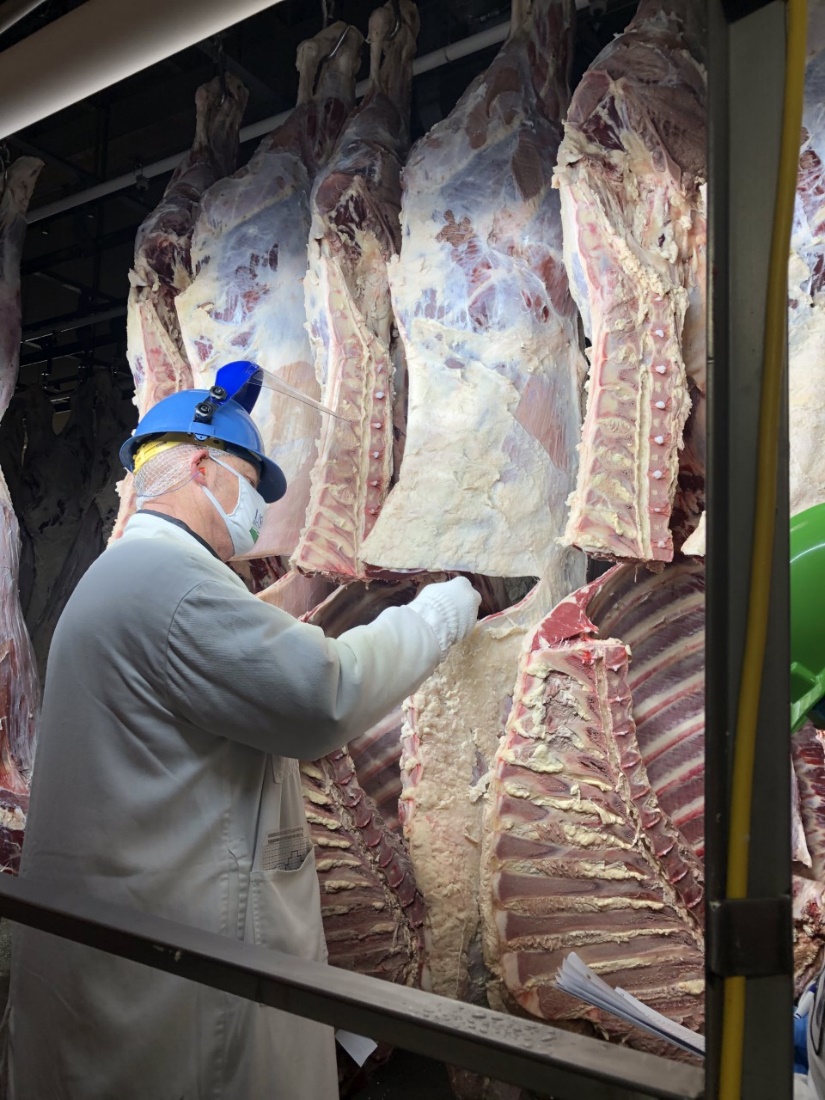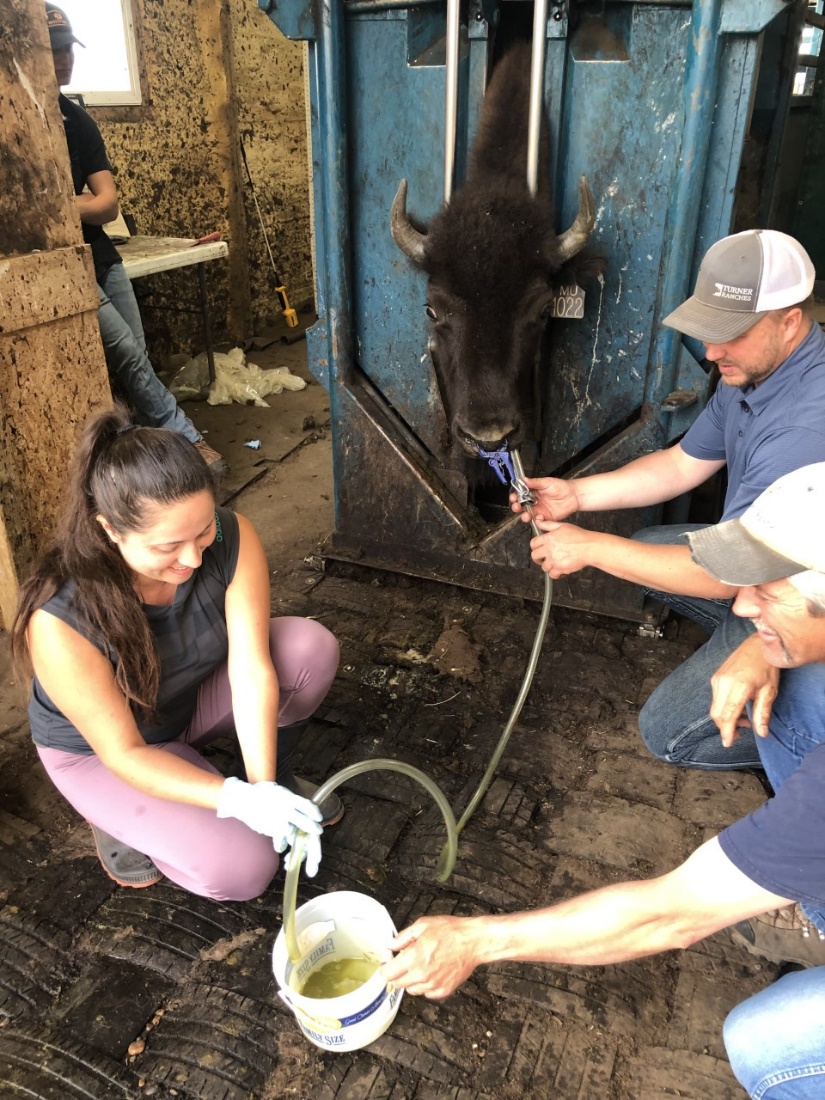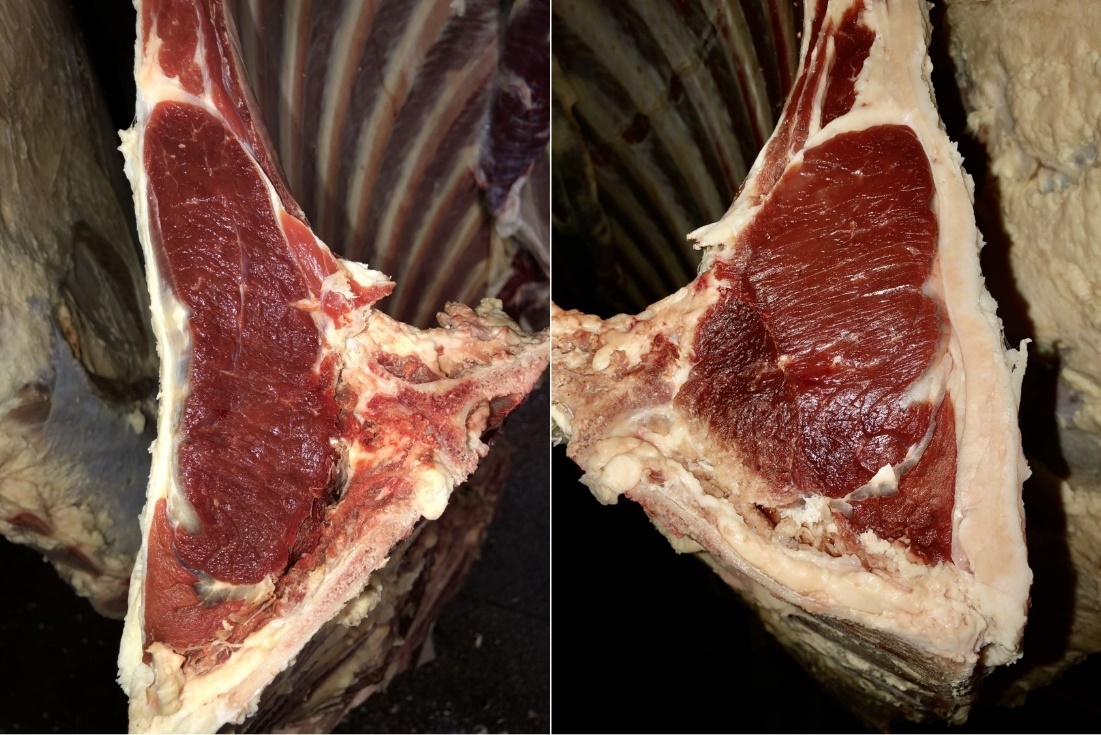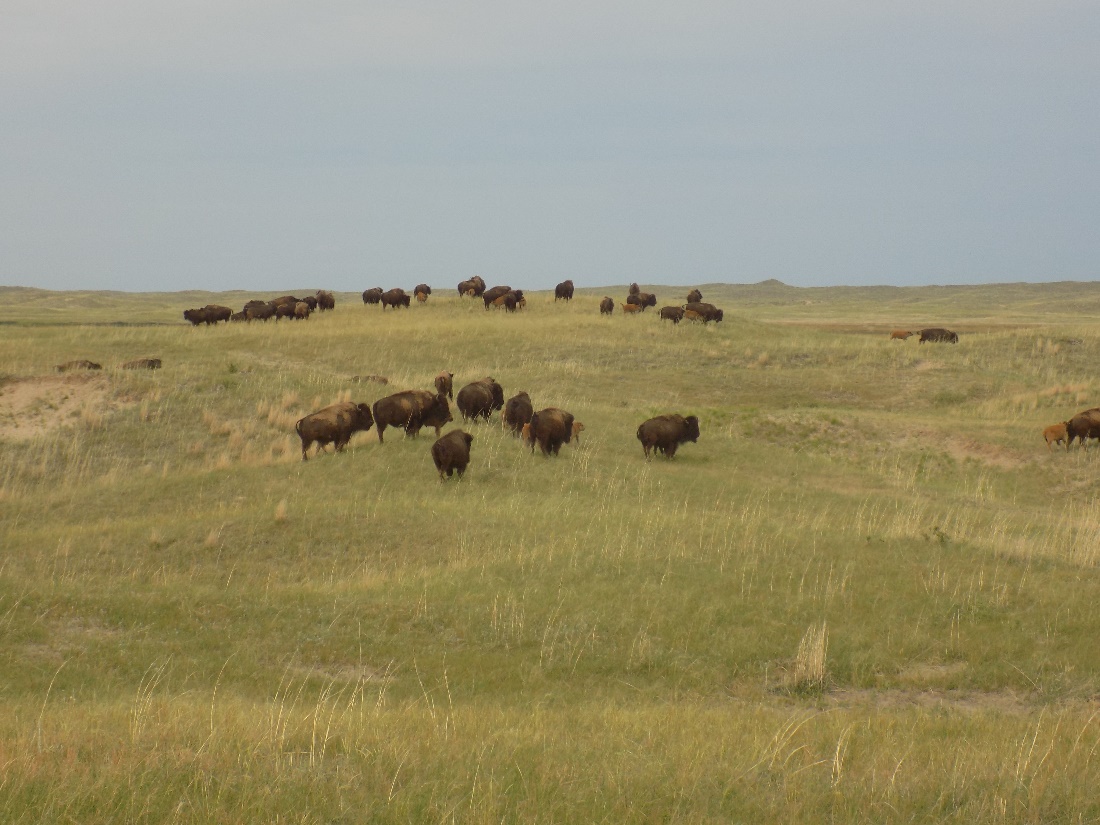Completed Projects
1. Characterization of bison finishing and harvest systems: Effects on carcass and meat quality characteristics of bison heifers.

Principle Investigators
- Dr. Amanda Blair, South Dakota State University, Department of Animal Science and Center of Excellence for Bison Studies
- Dr. Carter Kruse, Turner Institute of Ecoagriculture
Graduate Student.
Jessica Janssen, MS
Rationale. While commercial production and consumption of bison continues to increase, meat quality attributes such as healthfulness, tenderness, juiciness, flavor, and consumer preference of bison meat are not well understood. The Institute undertook this study to characterize the influence of finishing system (grain-based diet versus pasture diet) on carcass characteristics, meat quality, nutritional composition, and consumer preference for bison meat. Outcomes from this work will also help define more detailed studies on how animal diet variation and breadth influence bison meat nutritional profiles and healthfulness.Outcomes. Grain-finished bison heifers had greater live and hot carcass weights, dressing percentage, ribeye area, back fat, and marbling scores when compared to grass-finished. Steaks from grain finished heifers had increased crude protein and fat content and decreased moisture. Grain finishing produced steaks with increased cholesterol, palmitic, stearic, oleic, linoleic, arachidonic, and total fatty acids. Tenderness of all steaks improved with aging and grain finished steaks were more tender overall. Finishing system did not influence ultimate pH or sensory ratings by a consumer panel. Animals transported to and harvested at a commercial facility had elevated cortisol levels compared to those harvested on-ranch (mobile abattoir). For a more complete summary please see the following:
Janssen, J., K. Commack, J. Legako, R. Cox, J. Grubbs, K. Underwood, J. Hansen, C. Kruse, and A. Blair. 2021. Influence of grain- and grass-finishing systems on carcass characteristics, meat quality, nutritional composition, and consumer sensory attributes of bison. Foods 10(5): 1060. https://www.mdpi.com/2304-8158/10/5/1060
Jannsen, J. 2020. Characterization of bison finishing and harvest systems: effects of carcass and meat quality characteristics. MS Thesis. South Dakota State University. https://openprairie.sdstate.edu/etd/4186/
Blair, A., J. Martin, and J. Janssen. 2022. Does diet matter: influence of bison finishing systems on composition and meat quality. Bison World (winter):18-23. https://www.researchgate.net/publication/358536282_Does_diet_matter_Influence_of_bison_finishing_systems_on_composition_and_meat_quality
2. Characterization of the rumen bacterial communities of bison heifers fed a grass-based diet vs a grain-based free-choice diet.

Principle Investigators
- Dr. Benoit St-Pierre, South Dakota State University, Department of Animal Science
- Dr. Carter Kruse, Turner Institute of Ecoagriculture
Graduate Student.
Anlly Miley Fresno Rueda, MS
Rationale. Ruminant animals depend on a diverse microbial community (e.g., bacteria, archaea, protozoa, and fungi) in their rumen to digest the structural carbohydrates of forage diets. Ruminal microbe communities are relatively understudied in North American bison. There is also an indication that bison may be better adapted and perform better than domestic ruminants when feeding on low-quality forages, which may be related to ruminal communities. This Institute study compared the diversity and composition of ruminal bacteria in bison heifers fed a grass-based and then grain-based diet in order to characterize the overall bacterial community and changes that occur when diet is shifted from natural forage to high energy grains. A better understanding of the bison rumen microbiome will ultimately lead to practical applications for their conservation and production.
Outcomes. Bacteriodes and Firmicutes were the dominate bacteria phyla across all samples collected. A total of 57,132 and 59,133 species-level operational taxonomic units (OTU’s) were identified in the grass-fed heifers at two study locations, respectively, in contrast to 13,240 and 22,516 OTUs found in the same heifers on a grain-based diet. At the first location, 28 of the most abundant OTUs were different between diets, while 17 were different at the second location. Only 74 OTUs were considered abundant (representing >1% of total sequences in at least one sample) and most of these (69) were from unknown bacterial species. For a more complete summary please see the following:
Fresno-Rueda, A. 2021. Characterization of the rumen bacterial communities of bison heifers fed a grass-based diet vs a grain-based free-choice diet. MS Thesis. South Dakota State University.
http://openprairie.sdstate.edu/etd/5744
3. Characterization of bison finishing and management systems: Effects on carcass traits, meat quality, and sensory attributes of bison bulls.

Principle Investigators
- Dr. Amanda Blair, South Dakota State University, Department of Animal Science and Center of Excellence for Bison Studies
- Dr. Carter Kruse, Turner Institute of Ecoagriculture
Graduate Students.
- Clay Newton, MS
- Lydia Hite, PhD
Rationale. While commercial production and consumption of bison continues to increase, meat quality attributes such as healthfulness, tenderness, juiciness, flavor, and consumer preference of bison meat are not well understood. This Institute study was undertaken to characterize the influence of finishing system (grain-based diet versus pasture diet) and animal age on carcass characteristics, meat quality, nutritional composition, and consumer preference for bison meat. Outcomes from this work will also help define more detailed studies on how animal diet variation and breadth influence bison meat nutritional profiles and healthfulness. This study on bison bulls is a companion study to our previous work on bison heifers.
Outcomes Grain-finished bison bulls had greater live and hot carcass weights, dressing percentage, ribeye area, back fat, and marbling scores when compared to grass-finished. Grass-finished bulls had moderately yellow fat compared to grain-finished. Steaks from grain-finished bulls had increased crude protein and fat content, and decreased moisture. Grain finishing produced steaks with increased cholesterol and higher concentrations of monounsaturated fats, while polyunsaturated fats were higher with grass finishing. Grass-finished steaks were more tender at 4 and 7 days of aging, but there was no difference after 14 days. Tenderness of all steaks improved with aging and freezing. Sensory ratings by a consumer panel comparing grain- and grass-finished steaks did not differ for overall liking, texture, toughness, juiciness, or flavor intensity, but panelists preferred the aroma and overall flavor of grain-finished bulls. Older bulls were heavier and larger but age did not influence skeletal maturity (ossification) between bison bulls at 29 and 36 months of age. Older bulls were significantly tougher and required 21 days of aging to reach an acceptable level of tenderness. For a more complete summary please see the following:Newton, C.J. 2022. Effect of finishing system and animal age on carcass traits and nutritional profile of bison bulls. MS Thesis. South Dakota State University.
4. Pasture-finishing of bison improves animal metabolic health and meat nutritional qualities.

Principle Investigators
- Dr. Stephan van Vliet, Utah State University, Department of Nutrition, Dietetics, and Food Sciences
- Dr. Amanda Blair, South Dakota State University, Department of Animal Science and Center of Excellence for Bison Studies
- Dr. Carter Kruse, Turner Institute of Ecoagriculture
Rationale. Adaptive grazing of bison on rangelands has the potential to be regenerative and produce positive ecosystem effects. This outcome, coupled with growing consumer demand for sustainably raised, healthier meat products has led to an increase in livestock producers implementing agro-ecological management, including rotational grazing and pasture-finishing of animals, to improve ecological, animal, and human health. Consumer interest in pasture-finished meat (i.e., grass-fed) has raised several questions about its nutritional quality. The goal of this Institute study was to determine the impact of two common finishing systems in bison (pasture-finished or pen-finished in confinement on corn) on metabolomic, lipidomic, and fatty acid profiles in bison.
Outcomes. Main metabolite classes that discriminated between pasture- and pen-finished bison bulls were amino acids (94/162 metabolites differed); lipids (83/138 metabolites), carbohydrate metabolites (29/44 metabolites), xenobiotics/phytochemicals (16/27 metabolites), and vitamins & co-factors (13/28 metabolites). Pen-finished individuals had higher glucose, triglycerides, oxidative stress, and amino acid protolysis, indicating impaired metabolic health compared to pasture-finished individuals. Pasture-finished animals also had lower levels of a common advanced glycation end product (N6-carboxymethyllysine) while having higher levels of long-chain saturated and mono-unsaturated carnitines, which associate with improvements in metabolic health. Pasture-finishing also concentrated higher levels of phenolics, alpha-tocopherol, carotene, and very long-chain saturated fatty acids (saturated and unsaturated) in meat; compounds considered favorable for human health. Our study represents one of the deepest meat profiling studies to date, having identified 1500 compounds. We conclude that pasture-finishing (i.e., grass-fed) improves bison metabolic health and nutrient density of their meat compared to finishing bison on grain-based concentrates in pens. For a more complete summary please see the following:
van Vliet, S., A. D. Blair, L. M. Hite, J. Cloward, R. E. Ward, C. Kruse, H. A. van Wietmarchsen, N. van Eekeren, S. L. Kronberg, and F. D. Provenza. 2023. Pasture-finishing of bison improves animal metabolic health and meat nutritional qualities. In review.
